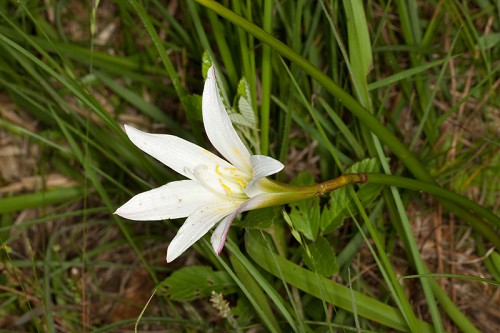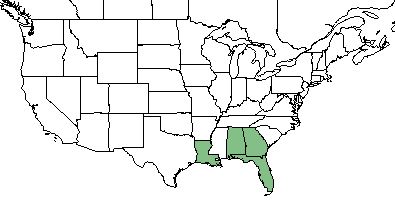Difference between revisions of "Zephyranthes treatiae"
(→Description) |
|||
| Line 34: | Line 34: | ||
===Phenology=== <!--Timing off flowering, fruiting, seed dispersal, and environmental triggers. Cite PanFlora website if appropriate: http://www.gilnelson.com/PanFlora/ --> | ===Phenology=== <!--Timing off flowering, fruiting, seed dispersal, and environmental triggers. Cite PanFlora website if appropriate: http://www.gilnelson.com/PanFlora/ --> | ||
| − | It flowers between January and April, peaking in March,<ref name="Ladybird"/><ref>Nelson G. (15 December 2017) PanFlora. Retrieved from gilnelson.com/PanFlora/</ref> and producing white flowers that fade to pink. | + | It flowers between January and April, peaking in March,<ref name="Ladybird"/><ref>Nelson G. (15 December 2017) PanFlora. Retrieved from gilnelson.com/PanFlora/</ref> and producing white flowers that fade to pink.<ref name="Ladybird"/> Flowers are broadly funnelform with reflexed perianth segments and exserted stigmas.<ref name="Flagg & Smith 2008"/> |
<!--===Seed dispersal===--> | <!--===Seed dispersal===--> | ||
<!--===Seed bank and germination===--> | <!--===Seed bank and germination===--> | ||
Revision as of 15:59, 15 December 2017
| Zephyranthes treatiae | |
|---|---|

| |
| Photo by John Gwaltney hosted at Southeastern Flora.com | |
| Scientific classification | |
| Kingdom: | Plantae |
| Division: | Magnoliophyta - Flowering plants |
| Class: | Liliopsida - Moncots |
| Order: | Liliales |
| Family: | Liliaceae |
| Genus: | Zephyranthes |
| Species: | Z. treatiae |
| Binomial name | |
| Zephyranthes treatiae S. Watson | |

| |
| Natural range of Zephyranthes treatiae from USDA NRCS Plants Database. | |
Common Name(s): zephyrlily,[1][2] Treat's zephyr-lily[2]
Contents
Taxonomic Notes
Synonym(s): Atamosco treatiae; Z. atamasca var. treatiae[1][2]
Description
Z. treatiae is a monoecious perennial forb/herb[2] that can reach heights of 10 in (0.25 m).[3] They are typically found singly or loosely clumped.[4]
Distribution
It can be found in southern portions of Georgia, south to central penisular Florida,[1][2] and occurrences in Alabama and Louisiana. In Florida, Z. treatiae is listed as a threatened species.[2]
Ecology
Habitat
Zephyranthes treatiae is associated with wet savannas,[1] and pine flatwoods.[4]
Phenology
It flowers between January and April, peaking in March,[3][5] and producing white flowers that fade to pink.[3] Flowers are broadly funnelform with reflexed perianth segments and exserted stigmas.[4]
Conservation and Management
Cultivation and restoration
Photo Gallery
References and notes
- ↑ 1.0 1.1 1.2 1.3 Weakley A. S.(2015). Flora of the Southern and Mid-Atlantic States. Chapel Hill, NC: University of North Carolina Herbarium.
- ↑ 2.0 2.1 2.2 2.3 2.4 2.5 USDA, NRCS. (2016). The PLANTS Database (http://plants.usda.gov, 15 December 2017). National Plant Data Team, Greensboro, NC 27401-4901 USA.
- ↑ 3.0 3.1 3.2 Plant database: Zephyranthes treatiae. (15 December 2017).Lady Bird Johnson Wildflower Center. URL: https://www.wildflower.org/plants/result.php?id_plant=ZETR
- ↑ 4.0 4.1 4.2 Flagg R. O. and Smith G. L. (2008). Delineation and distribution of Zephyranthes species (Amaryllidaceae) endemic to the southeastern United States. Castanea 73(3):216-227.
- ↑ Nelson G. (15 December 2017) PanFlora. Retrieved from gilnelson.com/PanFlora/